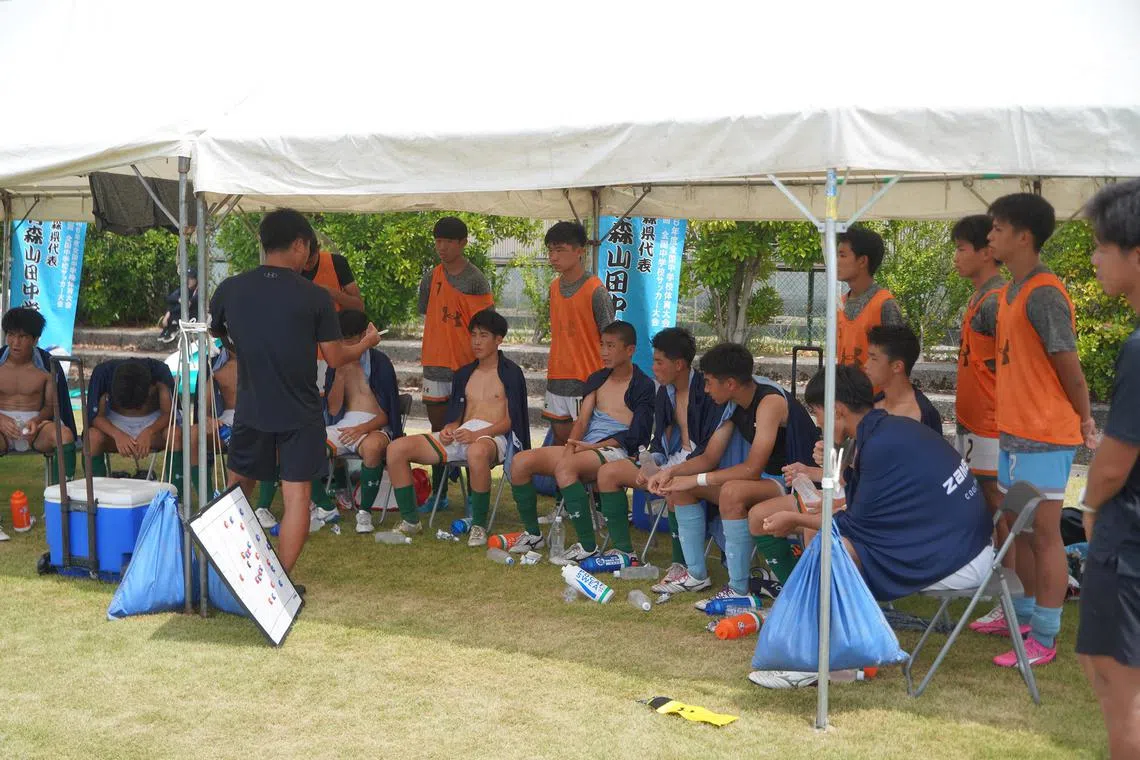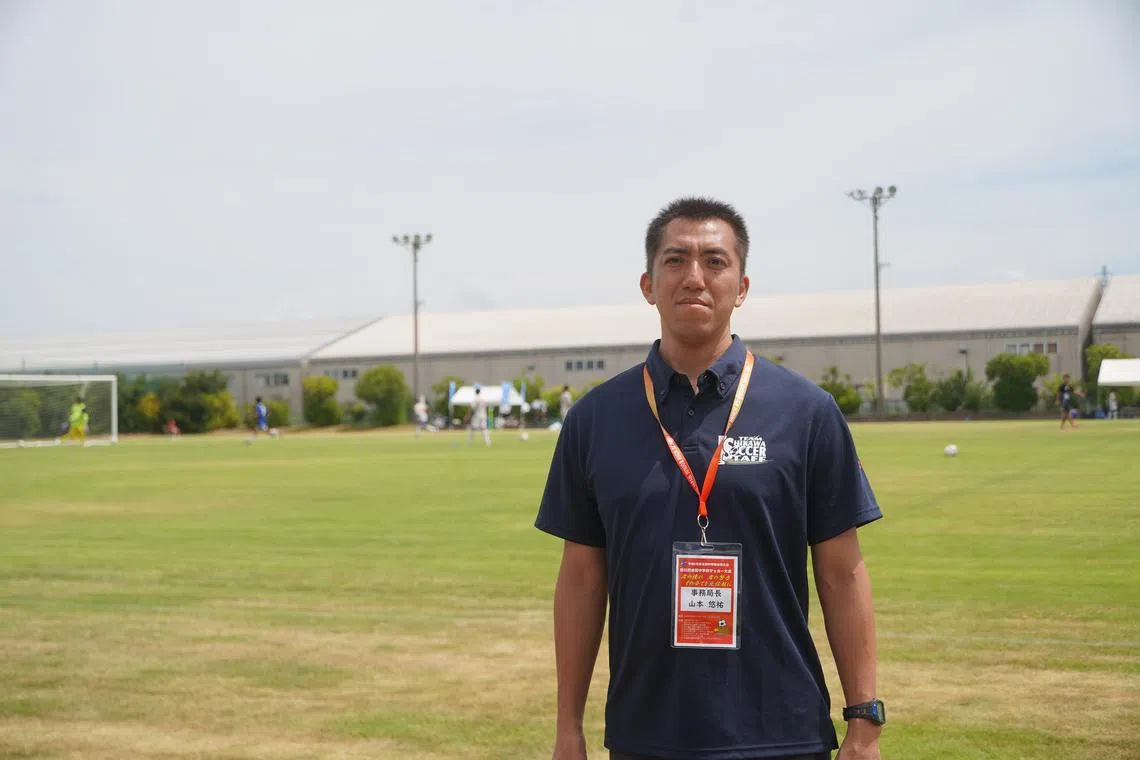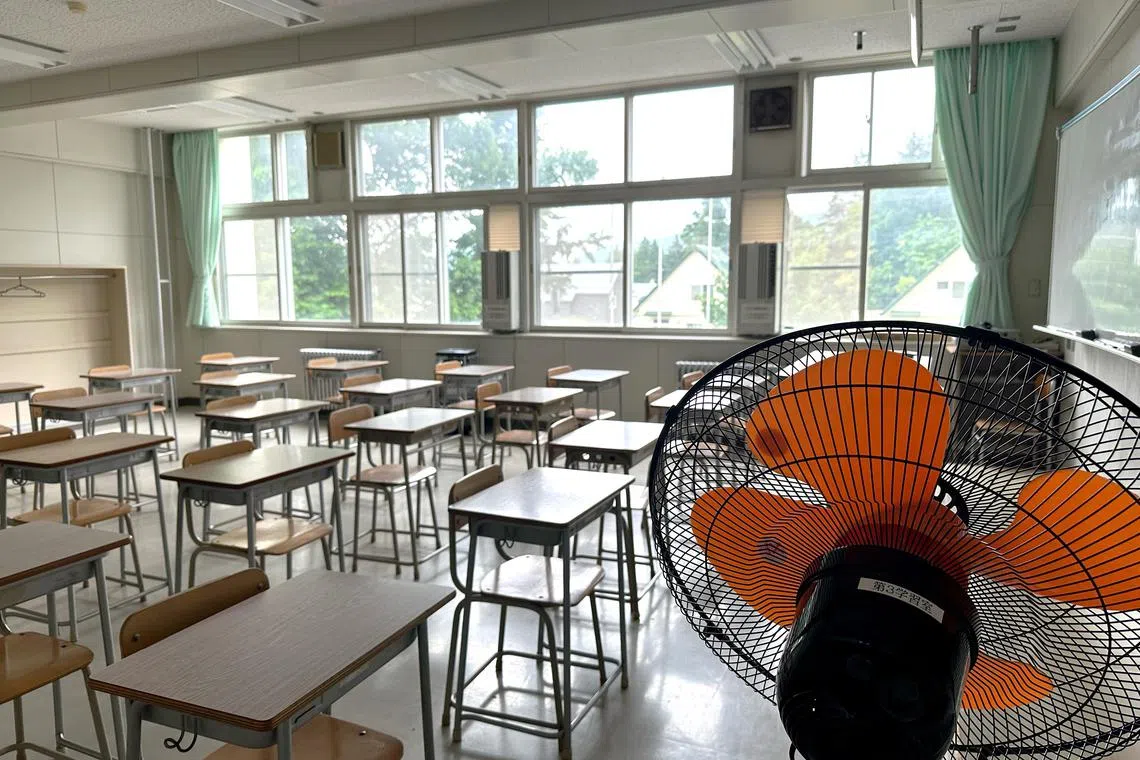Organisers of Japan’s school sports events ponder future amid harsher summers
Sign up now: Get ST's newsletters delivered to your inbox

National school sports tournaments are a traditional mainstay of Japanese summers, when school is out for an average of six weeks.
ST PHOTO: WALTER SIM
Follow topic:
TOKYO/KOMATSU, Ishikawa – It was Day 1 of the 55th annual national junior high school football tournament, and organising committee chief Yusuke Yamamoto was already getting a call bearing bad news.
A student cheerleader had been taken to hospital with symptoms of heat exhaustion following the opening round of matches on Aug 19. These were played at eight venues in coastal Ishikawa prefecture, where temperatures reached a maximum of 33 deg C.
Now Mr Yamamoto, like other officials of national school sports tournaments, is turning his mind to how best to safeguard children in increasingly excruciating heat, while not dampening the competition so looked forward to by players and spectators.
Hotter summers necessitate heat countermeasures such as mandatory cooling breaks for players in different tournaments. While experts note that “heat acclimatisation” training may allow athletes to become more resistant, they cannot be entirely immune to heat illness.
National school sports tournaments, accompanied by the drama of victory and defeat, are a traditional mainstay of Japanese summers, when school is out for an average of six weeks.
Tournaments with long histories like the High School Baseball Championship, better known as Koshien and into its 106th year, are aired live on television and given front-page media coverage. Students – often seniors in the graduating cohort – must first emerge victorious in their local prefecture or regional bloc to earn the right to compete on the national stage.
And what is at stake is not just pride: For many, they mark the final chance to don their jerseys and be spotted. High school talent has been scouted for the big leagues, like baseball’s Shohei Ohtani, who now plays for the Los Angeles Dodgers in Major League Baseball in the United States. Those younger may be scouted by amateur clubs or earn through-train passage to sports-centric schools.
“We take it for granted, but summer is truly a special season,” Mr Yamamoto, 43, told The Straits Times at the football tournament headquarters in Komatsu, which experienced a record 40 deg C day in 2023.
He would know: The physical education (PE) teacher himself was on his junior high school’s football team.
But that was three decades ago, when “it would rarely even hit 30 deg C” in his native Ishikawa prefecture. Now, such temperatures are to be expected in the dog days of Japanese summers, with the mercury often breaching the 35 deg C threshold that the Japan Meteorological Agency (JMA) describes as “disaster-level heat”.
Japan’s 47 prefectures take turns to host the football competition, which features 32 teams from across the country. A five-minute cooling break is mandated at the 20-minute mark in each of the 30-minute halves, when players retreat to their sheltered benches to cool off.
But Mr Yamamoto said there was already talk within the Japan Football Association of moving the tournament permanently to more temperate climates like Hokkaido, Japan’s northernmost prefecture.

Mr Yusuke Yamamoto said there was already talk within the Japan Football Association of moving the tournament permanently to more temperate climates.
ST PHOTO: WALTER SIM
Yet even Hokkaido’s cooler weather cannot be taken for granted. In 2023, an eight-year-old girl died of heatstroke in the Hokkaido city of Date after a PE lesson when the mercury hit 33.5 deg C.
This was despite the class reportedly ending 20 minutes early, with seven teachers watching the children, and the girl rehydrating six to seven times.
Also in 2023, a 13-year-old girl died while cycling home after club activities in Yamagata prefecture, while there have also been reported cases of heat exhaustion in swimming pools.
Japan’s Fire and Disaster Management Agency said that as at Aug 18, a total of 76,527 people were admitted to hospital for heat illness in 2024, of whom 103 died. Among the sufferers were 6,845 children aged eight to 17, or 8.9 per cent.
Many heat exhaustion victims – 30,352 people, or 39.7 per cent – were at home, while another 2,834 people – or 3.7 per cent – were in education facilities.
Dr Naoto Fujii of University of Tsukuba told ST that the younger the children, the more sensitive they are to heat, as their bodies are less able to regulate temperatures.
He also warned that products such as neck coolers and portable fans that are getting widespread use help only to a certain extent.
They cool only a single area and do not help to reduce core body temperatures, unlike measures such as taking cold or frozen drinks like slushies, or isotonic drinks that replenish electrolytes and help ensure hydration.
Sports scientist Yuri Hosokawa of Waseda University said that heat illness develops when multiple risk factors are present simultaneously, though these vary among individuals.

Solar reflection sheets are placed on windows to block sunlight and keep indoor temperatures cool at Yubari High School in Hokkaido.
PHOTO: YUBARI HIGH SCHOOL
Dr Hosokawa, who is also an adviser to the non-profit Sports Safety Japan, wondered if the entire school sports schedule should be overhauled.
“While we have the tradition of hosting major sports tournaments in the summer in Japan, we need to revisit the annual schedule to safeguard our athletes,” she said, but acknowledged that this would not be an easy task given the academic calendar. (Winter holidays, while shorter, already have two major events – the Hakone Ekiden university relay marathon, and the All-Japan High School Soccer Championship)
“If changing the schedule is not feasible, we should, at a minimum, consider having these events in a more controlled environment,” she said, citing the possibility of covered stadiums or indoor venues to reduce environmental heat stress.
The grand dame of summer competitions is Koshien, where 49 baseball teams from across Japan duke it out annually at the Hanshin Koshien Stadium in Hyogo prefecture.
It, too, has had its fair share of heat illnesses over the years – despite the athletes acclimatising to heat through rigorous and regimental training – that are triggered by ground conditions and worsened by nerves.
Thirty-four players, as well as 241 spectators and ground staff, suffered heat illness in 2023, with the corresponding figures being 51 and 152 respectively a year earlier.
“Summer heat is becoming more severe due to climate change, and we are making efforts to prevent heat illness while considering how to make high school baseball sustainable for the next century,” a Koshien spokesman told ST.
Among the initiatives in place are more rest days between matches and earlier starting times for the semi-finals and finals, while the number of players permitted on the bench was raised from 18 to 20 in 2023 to allow for more substitutes.
Also from 2023, a mandatory 10-minute “cooling time” was introduced after the fifth inning, for players to retreat to their benches and rehydrate.
“We are striving to make cooling time more effective based on practical experience,” he said, adding that doctors and physical therapists are on standby to respond to heat illness among players and spectators.
Halfway across the country in Tokyo, the 44th All-Japan Elementary School Rubber Baseball Tournament – dubbed Koshien for elementary pupils – was held concurrently at the Meiji Jingu Stadium, featuring 51 teams that qualified through local heats involving as many as 10,000 teams.
Mr Yoshio Koyama, senior managing director of the Japan Rubber Baseball Association, told ST that from 2024, team coaches must complete a daily health checklist to identify at-risk cases among their players.
Other initiatives in place include cooling breaks, holding games in the mornings and evenings, and allowing two parents to join the team on the bench to monitor children for signs of heat exhaustion.
“We are constantly wondering what might happen, and whether it will be possible to continue holding the tournament in summer,” Mr Koyama said. “When the goal of players is to win, they could end up overexerting themselves.”
As hotter summers affect school sports tournaments, longer summers are also posing a challenge for educators, especially in older schools, which are generally uninsulated from the heat. The JMA’s forecast on Aug 20 said summer temperatures are expected to persist well into October 2024.
In Hokkaido, the local education board has urged schools to install air-conditioning units in classrooms and gyms.
Principal Takayasu Hamamura of Yubari High School told ST that basic portable air-conditioning units and large fans have been installed since 2023.

Basic portable air-conditioning units and large fans have been installed in Yubari High School since 2023.
PHOTO: YUBARI HIGH SCHOOL
“But their cooling capacity is not sufficient, and it is barely enough to avoid heat exhaustion indoors,” he lamented, noting that the school lacks the budget and electricity capacity to operate proper air-conditioning units.
Orthopaedic doctor Ryoji Kasanami of the Nara University of Education, an expert on heat countermeasures, told ST that heat exhaustion prevention must consist of both management and personal awareness.
“No matter how many preventive measures are taken, I don’t think heat exhaustion cases can be stopped unless we raise the awareness among students through education and enable them to listen to their body and take care of themselves,” said Dr Kasanami, who chairs the medical committee at the Japan Triathlon Union.


